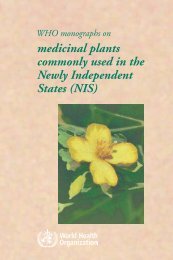Drug-Resistant Malaria - libdoc.who.int - World Health Organization
Drug-Resistant Malaria - libdoc.who.int - World Health Organization
Drug-Resistant Malaria - libdoc.who.int - World Health Organization
You also want an ePaper? Increase the reach of your titles
YUMPU automatically turns print PDFs into web optimized ePapers that Google loves.
64 / CONTROL<br />
may develop from any surviving individual asexual forms. When any<br />
of these compounds are used for the treatment of established<br />
infections (in practice this will usually only refer to<br />
chloroquine), far larger numbers of asexual parasites will be<br />
exposed to them. Ultimately the number of parasites exposed to a<br />
drug is the product of the number of people taking the drug<br />
multiplied by the mean number of parasites per individual.<br />
Frequency of Resultant Mutants in Parasite Populations<br />
Various estimates have been made of the frequency with which<br />
mutants resistant to various antimalarial drugs occur in different<br />
species of malaria parasites of birds and of rodents, but no good<br />
estimates are available for P.falciparum. While the frequency of<br />
mutations resulting in parasites resistant to DHFR inhibitors<br />
appears to be greater than that for chloroquine, this depends very<br />
much on the parasite species. Estimates for pyrimethamine seem to<br />
su§gest that resistant mutants are present in the order of 1 in<br />
10 parasites or less in natural populations of both<br />
P.gallinaceum and P.falciparum. While no estimate is available<br />
for chloroquine, the relative frequencies would appear to be<br />
P.berghei > P.falciparum>,,>P.gallinaceum»P.vivax. Moreover, there<br />
seems to be a geographical variation in the mutation rate in<br />
P. falciparum as regards resistance to chloroquine, the rate being<br />
apparently higher in South-East Asia and South America than 1n<br />
Africa. However, host as well as parasite factors must play a<br />
role in the ease of manifestat ion of chloroquine resistance, and<br />
this may well account for the long delay before this phenomenon<br />
has become apparent on the African continent.<br />
Influence of <strong>Drug</strong>s on Parasite Transmission<br />
While antifols have a sporontocidal action against drugsensitive<br />
strains of P.falciparum, this "action is lost in parallel<br />
with decreasing sensitivity of the asexual stages. Chloroquine<br />
which has neither a sporontocidal action nor any action against<br />
mature gametocytes even of drug-sensitive strains of P.falciparum,<br />
appears to have a paradoxical action on the transmission of<br />
chloroquine-resis.ant parasites, and may actually enhance their<br />
infec t i vity to vec tor anophe lines. However, this may be re lated<br />
to the biological advantage of chloroquine-resistant P.falciparum.<br />
Primaquine which is, of course, not used for the prophylaxis or<br />
therapy of falciparum malaria, possesses a potent gametocytocidal<br />
action against both chloroquine or antifol-sensitive or -resistant<br />
parasites.<br />
Antimalarial <strong>Drug</strong>s Available and Their Roles<br />
Table 8 shows drugs or combinations 1n current use (see<br />
Appendix 5 for further details)
















